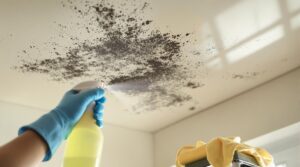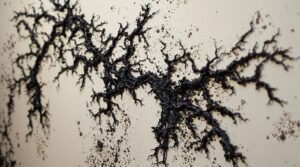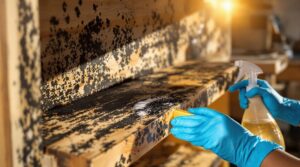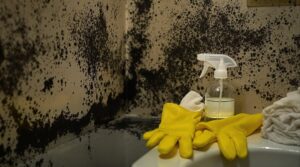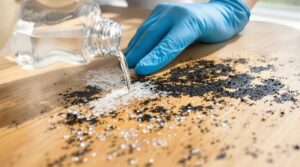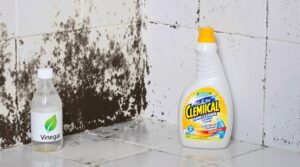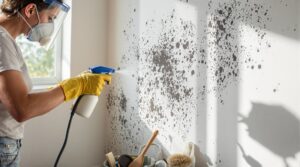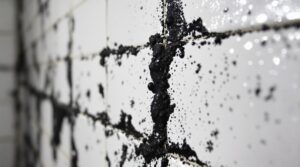Black mold remediation involves inspection, containment, removal, and resolving underlying moisture issues. Standard homeowners insurance policies typically cover mold remediation costs up to $10,000 if caused by a covered peril, but extensive removal costs can exceed $30,000. Homeowners should review policies, file claims promptly, and document damage thoroughly to maximize claims. Understanding the remediation process and insurance coverage limits can help mitigate future mold risks and uncover available options for addressing black mold infestations. Further exploration can reveal the benefits of professional guidance.
Key Takeaways
- Homeowners insurance may cover mold remediation costs if caused by a covered peril, such as a burst pipe, with coverage ranging from $1,000 to $10,000.
- The black mold remediation process involves inspection, containment, removal, and addressing moisture issues to prevent future growth.
- Professional services are recommended for major infestations or areas over 10 square feet, as mold remediation requires expertise for effectiveness.
- Average remediation costs range from $1,000 to $5,000, but larger infestations can exceed $30,000, and homeowners insurance may not fully cover extensive remediation.
- Working with public adjusters can increase claim settlements by 30-50%, as they provide expertise in navigating insurance claims and negotiating fair compensation.
Does Homeowners Insurance Cover Black Mold Remediation?
Homeowners insurance typically covers black mold remediation if it results from a covered peril, such as a burst pipe or water damage due to a malfunctioning appliance.
However, coverage limits for mold remediation under standard homeowners insurance policies usually range from $1,000 to $10,000. This may not fully cover extensive mold removal costs, which can exceed $30,000.
It is essential for homeowners to review their insurance policies to understand specific mold coverage details and potential exclusions related to black mold.
Filing a claim for black mold should be done promptly after discovery, as insurers may not cover mold damage claims filed beyond six months after the incident causing the mold.
Homeowners should be aware that mold damage claims can be denied if linked to neglect or lack of maintenance.
Working with a public adjuster can increase settlement amounts by up to 500% for non-catastrophic mold claims while providing objective damage assessments.
The Black Mold Remediation Process

Upon identifying black mold in their homes, many homeowners turn to remediation as a means to eliminate the issue.
The black mold remediation process involves a series of steps to guarantee effective mold removal. The following key steps are typically involved:
1. Inspection and Containment: A thorough inspection is conducted to identify the extent of mold growth and underlying moisture issues.
Containment measures, such as sealing off affected areas with plastic sheeting, are implemented to prevent mold spores from spreading during removal.
2. Mold Removal: Specialized cleaning agents and techniques, including HEPA vacuuming and damp wiping surfaces, are used to eliminate mold colonies and spores.
3. Moisture Issue Resolution: After remediation, it is essential to address the source of moisture, such as repairing leaks or enhancing ventilation, to prevent future mold growth.
Professional remediation is often necessary to guarantee effective mold removal and prevent further issues.
HEPA air scrubbers are installed to filter contaminated air and maintain optimal indoor air quality during the remediation process.
Identifying and Addressing Black Mold in Your Home
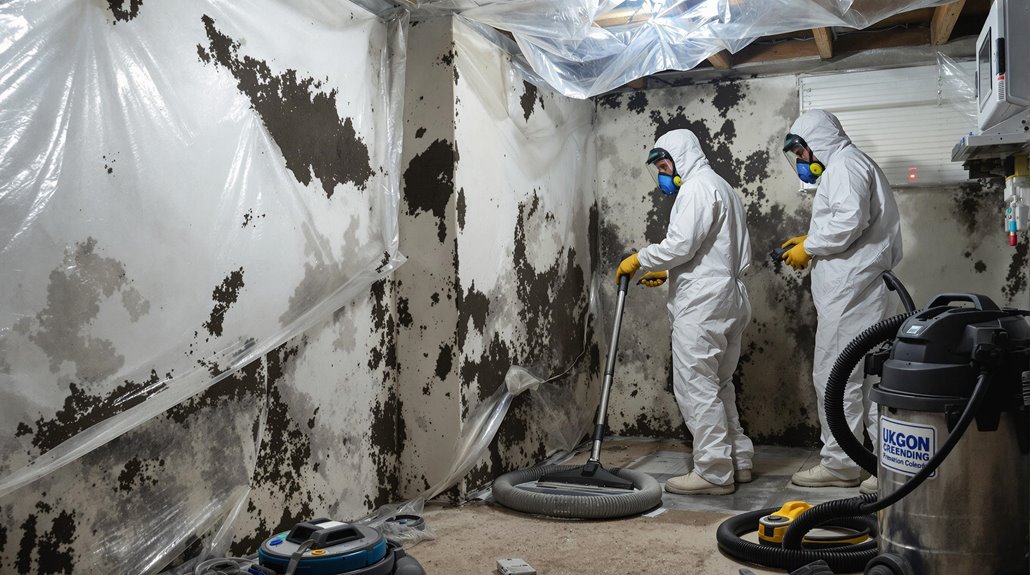
Identifying black mold in the home requires attention to signs such as musty odors, water stains, and visible growth, which often appear as dark green or black patches on surfaces.
Once identified, it is essential to address the issue promptly, as mold can develop rapidly within 24-48 hours of water damage.
Safe removal of black mold involves careful consideration of containment, personal protective equipment, and specialized cleaning protocols to prevent further contamination and exposure risks.
Areas exceeding 10 square feet of mold contamination require professional remediation services to ensure safe and complete removal.
Signs of Black Mold
Where does black mold typically thrive, and what are the telltale signs of its presence? Black mold flourishes in damp, humid environments, such as bathrooms, kitchens, and basements.
Common indicators of black mold include musty odors, visible mold growth on surfaces, and signs of water damage like stains or warped materials.
The following signs may indicate the presence of black mold:
- Visible mold growth: Black, green, or gray spots on surfaces, particularly in areas prone to moisture.
- Musty odors: Unpleasant, damp smells that persist despite cleaning and ventilation.
- Water damage indicators: Stains, warped materials, or mineral deposits, which can foster mold growth within 24-48 hours.
Any visible growth exceeding 10 square feet requires immediate professional remediation for safety.
If black mold is suspected, it's essential to document findings and consult your homeowners insurance policy to determine coverage for remediation.
Removing Black Mold Safely
Black mold remediation requires a detailed approach that prioritizes safety and effectiveness.
To remove black mold safely, it is vital to fix the source of moisture first, followed by safe removal using appropriate protective gear, such as gloves and respiratory masks.
Proper ventilation during and after remediation is also essential to prevent the spread of mold spores.
For major infestations or areas exceeding 10 square feet, it is advisable to hire a professional mold remediation service to guarantee thorough removal and minimize health risks.
Homeowners should also consider their home insurance options to cover mold problems.
A wide-ranging remediation plan can help mitigate the risks associated with black mold, guaranteeing a safe and healthy living environment.
Effective remediation techniques can also help prevent future mold problems.
Using white vinegar solution can effectively treat up to 80% of mold species when applied properly.
Filing a Homeowners Insurance Claim for Black Mold Damage

Filing a homeowners insurance claim for black mold damage requires a thorough understanding of the mold claim filing process and insurance coverage limits.
Homeowners should be aware that standard policies often have limited coverage for mold remediation costs, typically ranging from $1,000 to $10,000.
To navigate the claim process effectively, it is essential to comprehend the specifics of insurance coverage and any additional options for mold-specific protection.
Working with public adjusters can increase claim settlements by 30-50% through their specialized expertise in policy interpretation and damage assessment.
Mold Claim Filing Process
The process of filing a homeowners insurance claim for black mold damage can be complex and time-sensitive.
To guarantee a smooth mold claim process, homeowners must take specific steps.
- Prompt Notification: Notify the insurance agent promptly after discovering mold, ideally within six months of the incident that caused it.
- Documentation: Document all mold damage with photographs and gather evidence of the related incident to support the claim.
- Preserve the Scene: Avoid cleaning or removing damaged items before an insurance adjuster assesses the situation, as this can impact the claim process and subsequent mold remediation efforts.
Adhering to these steps is essential to determine the extent of insurance coverage for the mold remediation process.
Most insurance policies provide standard mold coverage between $1,000 and $10,000 per occurrence, depending on the specific terms.
Insurance Coverage and Limits
How much can homeowners expect their insurance to cover when it comes to mold remediation costs? Homeowners insurance typically covers black mold remediation costs if the mold results from a sudden and accidental event.
Coverage limits for mold damage in standard policies usually range from $1,000 to $10,000. However, extensive remediation costs can exceed $30,000 for significant infestations, leaving homeowners with substantial out-of-pocket expenses.
Homeowners should review their policies to understand the scope of their insurance coverage. Additional mold coverage can often be added as a rider to existing homeowner policies, providing enhanced protection against mold-related expenses.
Understanding insurance coverage and limits is vital in determining the extent of financial assistance available for mold remediation.
Preventing Black Mold Growth and Reducing Remediation Costs
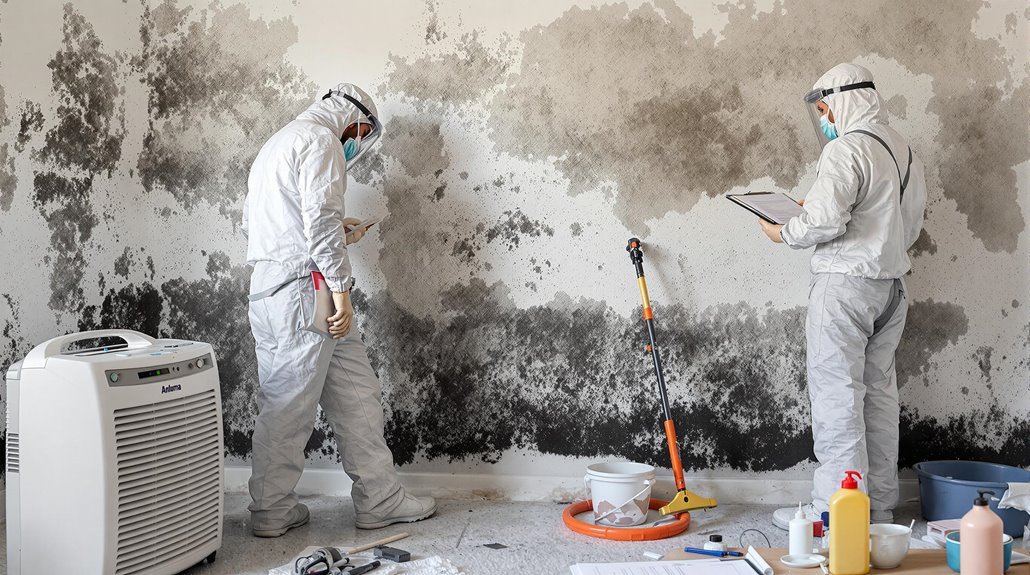
By controlling indoor humidity levels and addressing moisture accumulation, individuals can greatly reduce the likelihood of black mold growth and the associated remediation costs.
Maintaining indoor humidity levels between 30% and 60% can considerably reduce the likelihood of black mold growth, as mold thrives in moist environments.
Effective strategies to prevent mold from growing and reduce mold remediation costs include:
- Regular Inspections and Repairs: Promptly repair any leaks in plumbing or roofing to prevent moisture accumulation, which is a primary contributor to mold development.
- Proper Ventilation: Utilize exhaust fans in kitchens and bathrooms to ventilate moist air and minimize humidity, thereby decreasing the potential for mold growth.
- Informed Design Choices: Avoid using carpets in damp areas, such as basements and bathrooms, to prevent mold from establishing in these moisture-prone environments.
Understanding Black Mold Remediation Costs and Insurance Coverage Limits
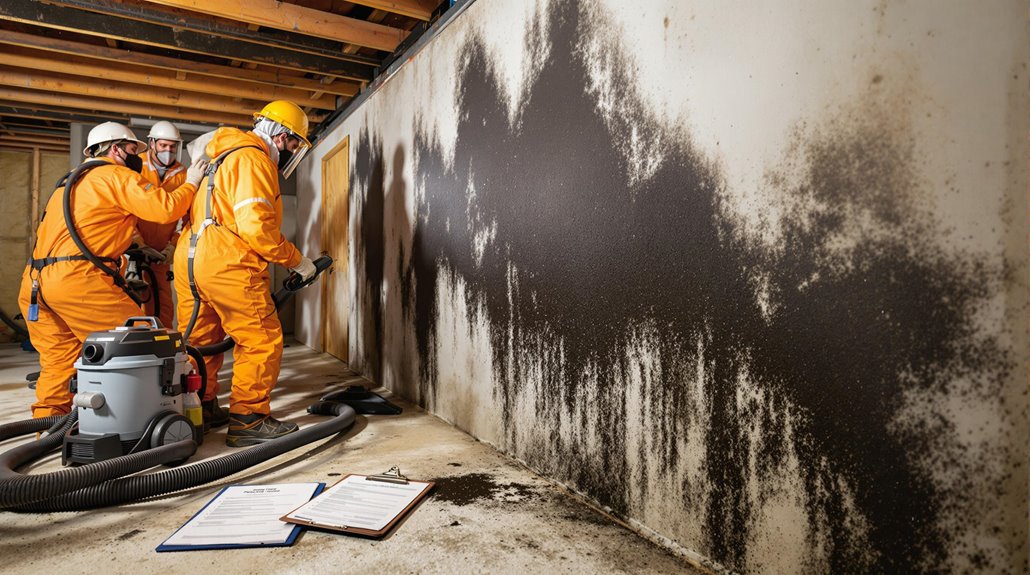
What exactly are the financial implications of discovering black mold in a home? Black mold remediation costs can range from $1,000 to $5,000 for average-sized homes, but larger infestations can exceed $30,000. Homeowners insurance typically covers mold remediation only if the mold resulted from a covered peril, such as a burst pipe or water damage from a fire.
| Mold Remediation Costs | Homeowners Insurance Coverage | Additional Coverage Options |
|---|---|---|
| $1,000 to $5,000 (average-sized homes) | $1,000 to $10,000 (standard policies) | Additional mold coverage can be purchased as a rider |
| Up to $30,000 (larger infestations) | May not fully cover extensive remediation costs | Increases premiums |
| Varies depending on infestation size | Requires prompt reporting and documentation | Recommended for high-risk areas |
Understanding the financial implications of black mold remediation is essential for homeowners. Homeowners insurance may cover some costs, but additional coverage options should be considered to guarantee adequate protection against extensive remediation costs.
The Benefits Of Consulting A Public Adjuster
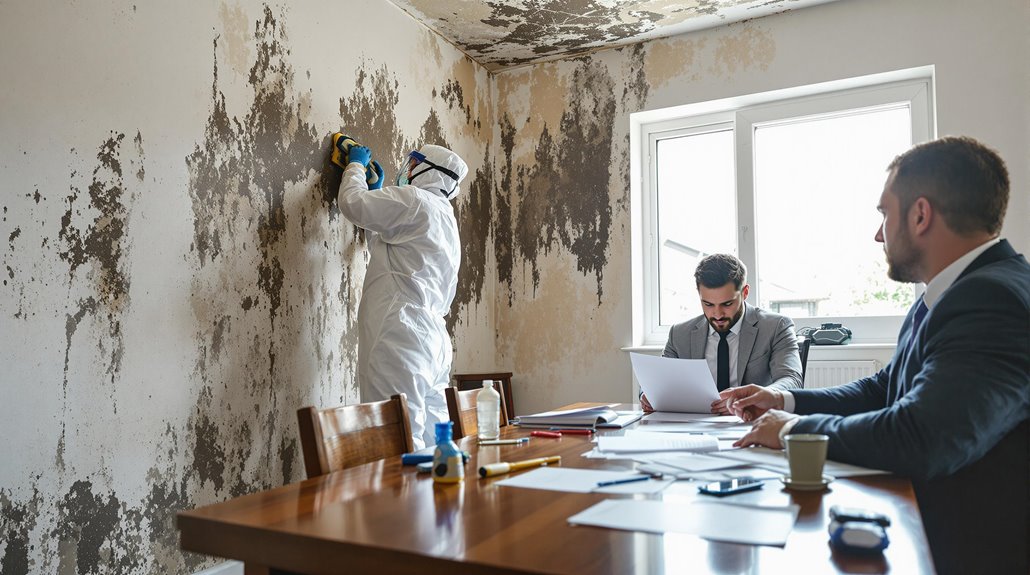
In the context of black mold remediation, consulting a public adjuster can provide policyholders with expertise in maneuvering through complex insurance claims and ensuring an objective damage assessment.
By engaging a public adjuster, policyholders can benefit from a streamlined claim process, leveraging the adjuster's knowledge of insurance policies and procedures to facilitate efficient claims resolution.
This expertise can ultimately result in higher claim payouts and settlements, as public adjusters are skilled in negotiating with insurance companies to secure fair compensation for policyholders.
Expertise In Insurance Claims
When dealing with mold remediation claims, the complexity of insurance policies can be overwhelming for homeowners, which is why consulting a public adjuster can be a valuable decision.
Public adjusters bring expertise in insurance claims, helping homeowners navigate policy language and identify covered perils that may have been overlooked.
Key benefits of consulting a public adjuster for mold remediation claims include:
- Policy interpretation: Public adjusters can decipher complex policy language to guarantee homeowners receive maximum coverage.
- Claim documentation: They assist in documenting mold damage and related costs, substantiating claims to insurance companies.
- Negotiation and advocacy: Public adjusters negotiate directly with insurers, saving homeowners time and stress, and advocating for their rights in disputes over coverage limits or claim denials.
Objective Damage Assessment
Approximately 70% of homeowners' insurance claims related to mold remediation are initially rejected or underpaid due to inadequate damage assessment and poor documentation.
Consulting a public adjuster can provide an objective damage assessment, ensuring accurate documentation and evaluation of the extent of the issue for insurance claims. Public adjusters are licensed professionals who work on behalf of policyholders, negotiating with insurance companies to maximize compensation for mold remediation costs.
They identify all covered perils that may have contributed to mold damage, increasing the likelihood of a successful claim. By utilizing a public adjuster, homeowners can alleviate the stress of maneuvering through complex insurance policies and claims processes, allowing them to focus on necessary remediation efforts.
Ultimately, this ensures a fair and accurate assessment of mold remediation costs.
Streamlined Claim Process
Frequently, homeowners struggling with mold remediation find the insurance claims process to be lengthy and arduous, often resulting in delayed or insufficient compensation. Consulting a public adjuster can alleviate these issues by streamlining the claims process.
Public adjusters have expertise in maneuvering through complex insurance policies, guaranteeing that all mold damage is accurately documented and presented to the insurance company.
Key benefits of consulting a public adjuster include:
- Accurate Documentation: Public adjusters guarantee that all mold damage is thoroughly documented, increasing the likelihood of a successful claim.
- Expert Policy Maneuvering: Public adjusters help homeowners understand their coverage limits and exclusions regarding mold remediation.
- Direct Negotiation: Public adjusters negotiate directly with the insurer, potentially resulting in a more efficient claims process and successful outcome for the homeowner.
Higher Claim Payouts & Settlements
While steering through the complexities of mold remediation, homeowners often face significant financial burdens. Consulting a public adjuster can be a strategic move to secure higher claim payouts.
With expertise in maneuvering insurance policies, public adjusters accurately assess damages and maximize compensation. Studies show that homeowners who engage public adjusters for mold claims typically receive settlements 20-30% higher than those managing the process independently.
By leveraging professional knowledge and negotiation skills, public adjusters guarantee that all related mold remediation costs, potentially exceeding $30,000, are accounted for in the claim filing process.
This expertise can lead to expedited claims processing, which is particularly vital for homeowners facing urgent remediation needs and potential health risks associated with mold exposure.
About The Public Claims Adjusters Network (PCAN)
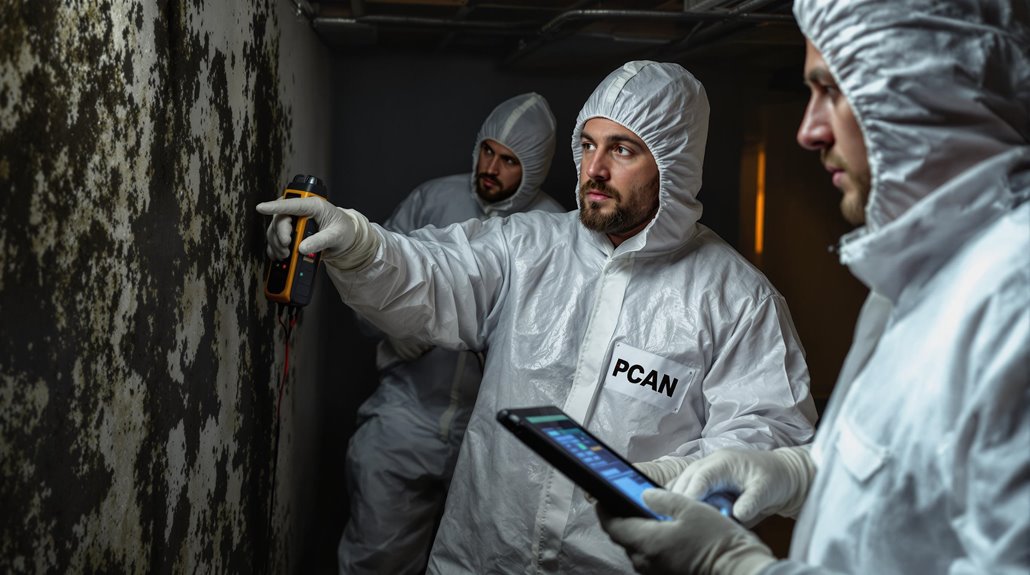
As a trusted resource for policyholders seeking expert guidance on property damage insurance claims, the Public Claims Adjusters Network (PCAN) stands as a national network of pre-vetted, verified, and state-licensed public adjusters.
PCAN serves as a connector between policyholders and expert public adjusters specializing in residential and commercial property damage insurance claims, including mold remediation.
Key Facts About PCAN
- Pre-vetted and Verified Adjusters: PCAN member adjusters undergo an intensive application and interview process to guarantee expertise in over 30 different claim types, including mold remediation.
- Highest Standards of Ethics: All PCAN member adjusters are held to the highest standards of ethics, morals, and professionalism, with mandatory yearly audits of their licenses and any complaints.
- National Network: PCAN member adjusters are located in 40+ states, providing policyholders with access to expert guidance on insurance claims, including mold remediation, across the nation.
Frequently Asked Questions
Does Insurance Cover Mold Remediation?
Ironically, many homeowners assume insurance always covers mold remediation, but the reality is more nuanced. Coverage depends on insurance policy details, requiring careful review. Mold prevention tips and informed remediation contractor selection also play vital roles.
Does House Insurance Cover Black Mold?
House insurance typically covers black mold if it results from a covered peril, such as sudden water damage. Reviewing insurance policy details and practicing mold prevention tips can mitigate health risks mold poses to occupants.
Who Pays for Mold Remediation?
Like a silent intruder, mold creeps in, bringing health risks and costly repairs. Homeowners typically pay for mold remediation, unless insurance coverage is applicable. Practicing mold prevention tips and using effective remediation techniques can mitigate these costs.
How Much Should I Pay for Mold Remediation?
Paying for mold remediation depends on factors like infestation size, location, and necessary services. Average costs range from $1,000 to $5,000, plus additional expenses for mold inspection costs, while prevention strategies and DIY remediation tips can reduce expenditures.

